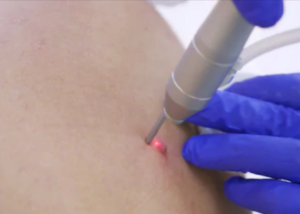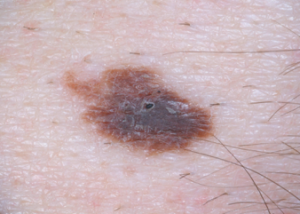You just had a melanoma removed and are now seeing new moles or little spots very close to the excision site.
The excision itself will not cause the formation of new moles, let alone malignant lesions.
But if you begin noticing what looks like new moles by the excision site of a melanoma, this is something you should not ignore.
“If there is blotchy pigmentation very close to or on the scar of a melanoma excision, it can represent recurrence of melanoma,” says Vishal Madan, MD, consultant dermatologist, laser and skin cancer surgeon, and founder/director of Everything Skin Clinic™.
Most likely the “recurrence” is actually the continued growth of melanoma cells that were not excised.
Even if the excision had generous margins of removed healthy tissue, it’s always possible for micro-metastases to get missed by a wide excision.
“A low threshold is kept for excision of this pigmented area for histological analysis,” says Dr. Madan.
“A new mole, if perfectly symmetric with benign features clinically and dermoscopically — even if near a melanoma excision site — should be observed and kept under surveillance.”
Dermatoscope:
A handheld magnifying tool with a special lens and light that enables a dermatologist to view a pigmented lesion’s features.

Shutterstock/LightField Studios
You can also just opt to have even the most normal-looking mole removed, if its location near a treated melanoma is causing you anxiety.
But make sure that it gets sent to the pathology lab for analysis.
Any removed mole, no matter how perfect its borders or even its color, should always be sent to the lab regardless of why it was removed.
Melanomas that appear near the excision site of a melanoma may also be new primary tumors, rather than the progression of missed cancer cells.
It could be coincidence that a new primary tumor is growing near where the first one was excised.
Or, it could be that the skin in that area has received a lot of sun damage and hence, the pigment cells (melanocytes) in that region are more vulnerable to gene mutation that transforms them into melanoma.

Specializing in the diagnosis and treatment of all skin conditions including melanoma, Dr. Madan has a special interest in skin cancer treatment, including Mohs micrographic surgery for basal cell carcinoma.
 Lorra Garrick has been covering medical, fitness and cybersecurity topics for many years, having written thousands of articles for print magazines and websites, including as a ghostwriter. She’s also a former ACE-certified personal trainer.
Lorra Garrick has been covering medical, fitness and cybersecurity topics for many years, having written thousands of articles for print magazines and websites, including as a ghostwriter. She’s also a former ACE-certified personal trainer.
.



























